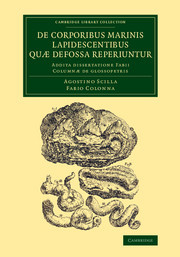Description
De corporibus marinis lapidescentibus quæ defossa reperiuntur
Addita dissertatione Fabii Columnæ de glossopetris
Cambridge Library Collection - Earth Science Series
Authors: Scilla Agostino, Colonna Fabio
Two foundational seventeenth-century texts on palaeontology, arguing for the animal origin of fossils, in an illustrated 1752 edition from Rome.
Language: English
Subject for De corporibus marinis lapidescentibus quæ defossa...:
Approximative price 28.98 €
In Print (Delivery period: 14 days).
Add to cart
Publication date: 07-2015
Support: Print on demand
Support: Print on demand
Description
/li>Contents
/li>
In 1747 the Roman publisher Venantius Monaldinus produced a Latin edition of two early works proposing the animal origins of fossils (reproduced here from the 1752 printing). The first, originally entitled La vana speculazione, first appeared in Italian in 1670. Its author, Agostino Scilla (1629?1700), was a skilled artist who painted fresco cycles in several churches in his native Sicily. From examining the fossils found in the strata on either side of the Strait of Messina and observing sedimentation in rivers, he deduced that not only molluscs but even the mysterious glossopetrae (actually fossilised sharks' teeth) were the remains of living organisms. The second essay, by Fabio Colonna (1567?1640), a Neapolitan botanist who corresponded with Galileo, appeared in 1616 as part of a longer Latin treatise, and also argues for the organic origins of glossopetrae. The book is illustrated by engravings of both fossil and living marine animals.
De corporibus marinis lapidescentibus; Fabii Columnae Lyncei de glossopetris dissertatio; Index tabularum; Tabulae I-XXVIII.
© 2024 LAVOISIER S.A.S.




